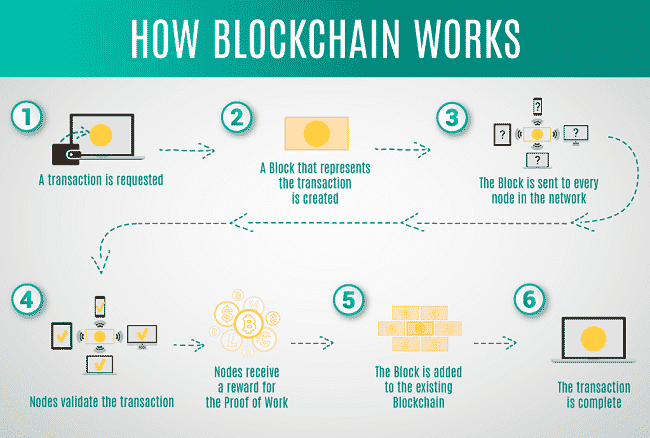
Back in 2008, the blockchain technology showed how different aspects of business would change. Even in its infancy, the technology disrupted numerous industries and industries. Diverse features like decentralization, immutability and accountability render Blockchain appealing to business sectors and domains worldwide. The banking and finance industry lead the way in the exploration of blockchain technology.
While a number of roadblocks exist, Blockchain undoubtedly possesses the ability to change the financial and banking industries by rising future costs and labor savings. According to a PwC survey, 24 percent of financial managers worldwide know blockchain technology well, with North Americans far more familiar than others. Taking into account the broad range of technical consequences, businesses are actively investigating ways to implement blockchain in many industries.
In fact, hundreds of thousands of funds are routinely moved every day from one area of the world into another in relation to banking and finance. This makes the global financial system one of the most common sectors that Blockchain could benefit from. The banking and finance industries are working under heavily dependent manual networks and vulnerable to errors and fraud which could result in a paralyzed money administration system. 77% of Fintech’s organizations plan to implement blockchain in their production system or processes by 2020, according to Global Fintech Study 2017.
Blockchain in Banking Sector

The main issue Blockchain poses with the fundamental understanding of the blockchain technology, and its functioning, is it really helpful for the banking sector? If so, how do we make best use of Blockchain for the industry? Above all, is blockchain staying here or heading?
Blockchain is going to do what the internet does to the government, according to a study of the Harvard Business Review. Blockchain has the power to address many issues even when it comes to banks and financial organizations. Blockchain technology has all the attractive features needed by reliable money technology. Secure, secure, open, transparent and reasonably cost-effective.
In the exchange of data, information and money Blockchain provides a extremely high degree of confidentiality and protection. It also allows consumers, by decentralization, to benefit from open network infrastructure and low operating costs. This makes Blockchain’s solution to banks and finance industries secure, promising and on-demand.
Financial institutions serve the essential task of keeping money safe and stable for citizens and the mechanisms in place therefore involve a lot of mediators. Those mediators ‘ presence is what makes the industry more costly. Moreover, the risks of mistakes and frauds are often rising with the presence of so many people and manual processes. Blockchain technology seeks to achieve the heavy weightlifting by securing transactions and making the overall consumer experience more fulfilling and less money consuming.
Which Banks Use Blockchain Technology?
While the word blockchain was viewed dismissively by banks and financial institutions in the early stages of its implementation, the picture has now started to change. With the success of Blockchain in various sectors, the banking industry is aggressively searching out new fields and applications of Blockchain technology.
Big names like JP Morgan Chase have devoted their faith to the future of Blockchain technology. The American multinational investment bank, based in New York City, has launched a new division called Quorum, primarily for the study and implementation of Blockchain technology. Quorum is a distributed ledger and smart contract platform for businesses that enable fast transactions and throughput addressing financial, banking and other challenges. According to infrastructure, they have already issued an annual deposit certificate based on a distributed variable-rate registry.
Other than these, the big U.S. bank, Bank of America has filed a patent application issued by the U.S. Department of patents and trademarks. The paper addresses the implementation of the approved blockchain for the protection of records as well as the authentication of business and personal data.
The system will allow only approved participants to access the data and maintain a record of all logging entries. In addition, the proposed system would use blockchain technology to merge several existing data storage systems into one. This stable single network would improve overall capacity and reduce the number of data storage locations for the user.
Another name on the list is Goldman Sachs, who is actively interested in work and support of distributed registry technology. They’ve invested in a cryptocurrency project named Circle. The project is considered to be one of the most well-funded startups in blockchain space. The goal is therefore to solve the main problem of volatility in the digital currency field, making the financial sector more stable with crypto options.
Supporting such a successful project, Goldman Sachs Group aims to become a pioneer in the adoption of cryptocurrency by its Wall Street competitors. They are also setting up their own cryptocurrency trading department, which will handle their digital trading exclusively.
Why should Banks Prefer Blockchain over Traditional Banking?
Present banking systems are extremely secure on paper and out-of-print. The Need of the Hour is to have an improved network designed with modern and modern technology that can withstand fraud, scalability and security issues. Blockchain technology and its decentralized nature will give the banking systems the much-needed edge they are looking for.
Banks can not be identified as autonomous, self-sufficient entities, as any transactions made through them still involve intermediaries. In addition, the pace at which the money is moved on an international scale may also take up to five days along with the risk involved. With a blockchain network in place, banks would be able to make transactions very fast without even having to take the risk burden on themselves, because the network would be self-sufficient to solve it on its own.
The world is going digital, and with this change, even small transactions and payments are going digitally. The rate of economic activity is rising and there is no question that the rate will continue to increase in the coming days. Blockchain technology can make small transfers feasible and fast with the aid of lower fees and scalability of transactions.
Financial institutions other than banks are continuously developing their platforms with the aid of state-of – the-art technology in order to protect markets by delivering commercially viable institutions at cheaper rates.Banking and other financial institutions should look forward to the adoption of new blockchain technology too in order to secure their place in the ecosystem.
Is it Difficult to Integrate Blockchain in Banking System?
Blockchain sure has its advantages in terms of adoption given its proposed features but there are some hurdles along the road as well which need to be addressed for banks and financial institutions to grow ahead with blockchain.
Interoperability:
The blockchain technology is not bounded by any international rules and regulations that place a standard to it. With the increasing need for interoperability among large industries like banks, the technology needs to be compatible with different systems and should hold the potential to get adopted by the masses. The integration of existing systems with a blockchain based model is a big challenge today as the current systems and processes cannot be entirely eliminated. If the actual adoption of blockchain allows multiple systems to work together smoothly, operational feasibility can be achieved.
Privacy:
Banks and financial institutions are the entities that are trusted by people for storing their funds. In order for blockchain to take their place, it is important to ensure that the data stored on the blockchain technology is kept securely and would not hamper the identity of any individual. As the transactions made on a public blockchain are publicly available, the need of exploring the potential of private blockchains for data-critical sectors is needed along with the resolution of issues like interoperability.
Encryption:
Private keys are the essential elements of a blockchain as they play a significant role in securing the data of an individual on the blockchain. However, a private key generated once has to be kept very securely as once it is misplaced or lost, there’s no way to get it back. Moreover, the encryption used to store data can be compromised by finding loopholes in the network which in turn, makes the blockchain susceptible to hacker attacks.
Security:
The blockchain network is secure and powerful as it is embedded with cryptography techniques. Cryptographic networks are complex to hack and thus, any kind of security breach in such networks would require a high amount of computational power in order to secure any hack. When a blockchain network is applied to any banking institution, it has to be secured with multiple security protocols. The network should be capable enough to restrict participating authorities to take control of the network only according to the access permission given to them. Depending upon the requirement, the blockchain involved in such systems or organisations could be permissioned or permission-less. People in an organisation need to be handled with different levels of access permissions in order to save the overall network from malicious insiders and cyber hackers.
Scalability:
Growth of existing databases is undeniable. The number of entries will keep on increasing as the number of people will continue to grow too. This poses a big challenge to the application of blockchain technology network. The network created through a blockchain should be able to handle the growing traffic while maintaining the speed of accessibility for the network participants. If the blockchain technology is applied to the current banking systems and institutions, it has to ensure the capacity of handling large volumes of data too.
Legal Regulations:

If blockchain is applied in the banking sector, the need for international and national regulations around it will become mandatory. Currently, cryptocurrencies, the most popular application of blockchain, do not have any regulations around them which makes them susceptible to both profits and losses. However, if and when blockchain finds its place in the banking or finance sector, the regulations need to be in place so as to avoid chaos among people in case of any losses.
Following strict jurisdictions in the banking sector, financial institutions have started to understand the potential of blockchain technology and see the appeal of cryptocurrencies in current markets. Big giants in the banking sector have started to check for the potential use of this decentralized technology in their business processes. In addition, some of the companies are also investing heavily in these start-up research and testing to develop blockchain-based solutions. With Blockchain joining the current scenario, a lot of challenges could be overcome while making the network more open, easy to access and secure.



